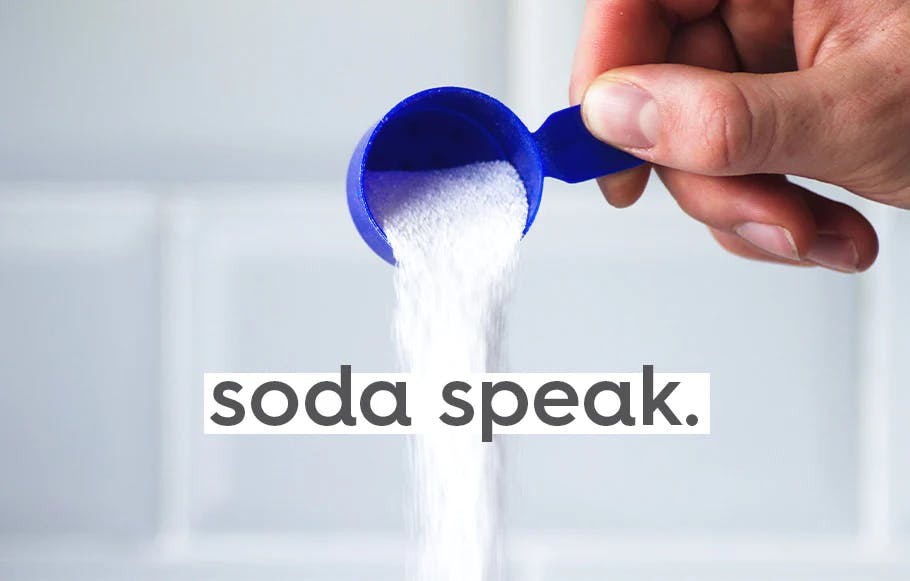22 Aug 2025
Bicarb cheat sheet:
- Baking soda and bicarbonate of soda are one and the same!
- Use as a natural deodoriser for funky fridges
- Banish soap scum, limescale and grime from shower trays with ease
- Soften your towels when you’ve run out of fabric conditioner
- Descale your kettle without the harsh chemicals
WAIT - what?! You mean baking soda and bicarbonate of soda are the same thing?!
Yes. It’s true. Here in the UK, we call it bicarbonate of soda. Over in the United States, they say baking soda.
Same magic powder. Different names. Both are pure sodium bicarbonate, a natural alkaline compound that reacts with acids like vinegar or lemon juice to create fizzing, dirt-busting bubbles.
we’re NOT talking soda crystals…
Soda crystals are different entirely. Soda crystals are much stronger, more alkaline, and often used for heavy-duty cleaning like removing grease, softening water, or unblocking drains. Bicarbonate of soda is gentler and better suited for deodorising, scrubbing, and mild stain removal.
cleaning with bicarb.
But while most of us know about bicarbonate of soda’s baking credentials (hello, perfectly risen cakes), did you know it’s also a powerhouse when it comes to cleaning?
Let’s dive into the science behind this humble ingredient and uncover its best-kept cleaning secrets.
1. a natural deodoriser.
If your fridge is smelling less fresh and more funky, bicarbonate of soda can absorb those odours in no time. Here’s a great hack to add to your regular clean routine. Simply:
- Mix 1 tbsp of bicarbonate of soda with 1 litre of warm water.
- Use a clean cloth (smol plant-based cloths are perfect!) to wipe down shelves, drawers, and walls.
- For extra freshness, leave an open pot of bicarb on a shelf. It’ll keep things odour-free for up to 3 months.
2. a gentle abrasive.
Shower tray looking a bit… grotty? Bicarb’s gentle scrubbing power can banish that soap scum, limescale and grime. Restoring order and a glorious shine!
- Loosen the grime: steam the shower by running hot water for a few minutes.
- Pre-clean: get foamy with smol refillable bathroom cleaner and wipe down.
- Make a bicarb paste: mix 5 tbsp of bicarbonate of soda with a little warm water (you’re aiming for a porridge consistency).
- Scrub-a-dub-dub: apply the paste, leave for an hour, then scrub in circular motions.
- Rinse away the dirt: wash the tray with warm water - hello, sparkle!
Extra tip: Bicarb isn’t great for glass or aluminium, so patch test first! And always wear gloves, as it can dry out your skin.
3. a surprising fabric fluffer.
Ever noticed your towels feeling a bit stiff, scratchy, or just… not as absorbent? It’s likely due to a buildup of detergent and fabric softener. Want to fix it?:
- Run a hot wash with half a cup of bicarbonate of soda instead of detergent.
- Add white vinegar to the rinse cycle (don’t mix vinegar and bicarb in the drum - they’ll cancel each other out!).
- Dry as normal - your towels will feel softer and smell fresher than ever.
4. a delightful descaler.
This kettle descaling hack is one we all need in our life because nothing ruins a cuppa like crunchy limescale floating in your tea. Bicarbonate of soda to the rescue!
- Mix 1 tsp of bicarb with 2 cups of water and pour into your kettle.
- Boil the kettle 4 or 5 times.
- Let it cool, then rinse well and wipe inside with a dry cloth.
For extra-stubborn limescale, add a splash of clear vinegar and repeat.
so should you stock up on bicarb?
Absolutely. It’s cheap, natural, and can replace so many of the harsher chemical cleaners in your home. Plus, when paired with a low-temperature wash and an eco-cycle, it helps keep your clothes, home, AND the planet fresher.
Have any other genius bicarb hacks? We’d love to hear them! Share your tips on Facebook or Instagram, and let’s keep things heavy on dirt, lighter on the planet.
